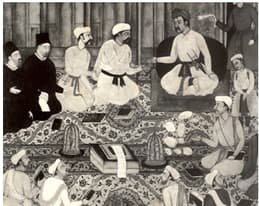Who was Akbar?
Important Questions on The Mughals (16th to 17th Century)
"As in the wide expanse of the divine compassion there is room for all classes and the followers of all creeds, so …in his Imperial dominions, which on all sides were limited only by the sea, there was room for the professors of opposite religions, and for beliefs, good and bad, and the road to intolerance was closed. Sunnis and Shias met in one mosque and Christians and Jews in one church to pray."
Who said the following lines about the policy of "Sulh-i-Kul"?
The third volume of Akbarnama is called _____. (Ain-i-Akbari/ Tawarikh)
Can you identify the Jesuit priests in this picture?

The author of Akbarnama is _____.
Abul Fazl, Akbar's friend and counsellor, helped him frame the ideas of _____(Sulh-i Kul/ Diwan-i-aam) so that he could govern a society composed of many religions, cultures and castes.
What were the responsibilities of Mir Bakhshi?

